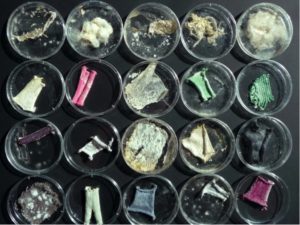
The production of leather and textiles is often a resource-heavy process, and the industries are responsible for diverse impacts, including human, animal or ecological, depending on the material type and production methods.
The growth in popularity of vegan lifestyle choices, as well as an increased concern for animal welfare in livestock farming, has prompted a number of developments in innovative materials as alternatives to animal skins. Among them is a leather substitute called mycelium leather, or muskin, which can be grown in the lab.
Muskin is made from crisscrossing fungus spores that are grown into a predetermined shape and size, which eliminates waste. The biodegradable material is processed similarly to leather, but without toxic chemicals. The process generates a soft material that is thick, strong and suede-like in texture. It’s being used for packaging, fashion accessories and in interior design applications.
Officina Corpuscoli is an Amsterdam-based multidisciplinary studio that works with living organisms, focusing on the industrial scale-up of mycelium-based materials, such as “Caskia, otherwise known as

“Growing a Mars Boot.” It was commissioned by the Museum of Modern Art (MoMA) as part of its Items: Is Fashion Modern? exhibition. In this case, fungal mycelium spores may be ideal because they minimize the volume of matter loaded onto a craft launched into deep space, but can then be cultivated to create a plethora of materials and tools during the journey.
Modern Meadow, a Brooklyn, N.Y.-based company, envisions a future in which animal products are animal-free and has a bioleather product, Zoa, created by optimizing cell-engineered collagen.
Many designers and engineers see living organisms as the future of clothing and other textiles, with living materials that can diagnose disease, treat and nourish us, and enhance our wellbeing. Suzanne Lee is the founder of Biofabricate, a conference that showcases how biotechnology can facilitate a new materials revolution. Her description of the process used to create bioleather resembles a kombucha recipe. Bacteria feed on sugar and spin cellulose during the fermentation process to form layers of fibers. Because only what is needed is grown, there’s no waste, and when the garment is at the end of its life, it can be thrown on the compost heap with the carrot peelings.
 TEXTILES.ORG
TEXTILES.ORG


